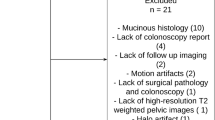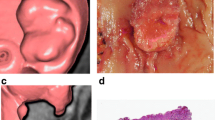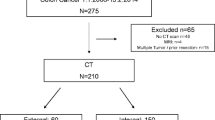Abstract
Purpose
We investigated whether or not computed tomographic colonography (CTC) is a viable alternative to double-contrast barium enema (BE) for a preoperative rectal cancer evaluation.
Methods
The size and distance from the anal canal to the lower or upper tumor borders were laterally measured in 147 patients who underwent CTC and BE. Measurements were grouped into early cancer, advanced, and after chemoradiation therapy (CRT).
Results
In the early and advanced cancer groups, all lesions were visualized by BE. In contrast, 3 (7.8%) early and 8 (7.3%) advanced cases, located at the anterior wall near the anal canal, were not visualized by CTC because of liquid level formation. In the CRT group, 16 (23.5%) and 4 (5.8%) cases were not visualized by CTC and BE, respectively. The BE and CTC size measurements were similar among cohorts. However, the distance from the anal canal's superior margin tended to be longer with BE, especially in early cancer. The differences in distance from the anal canal were significantly larger in the early cancer group than in the other two groups (p = 0.0024).
Conclusion
CTC may be a viable alternative imaging modality in some cases. However, BE should be employed in anterior wall cases near the anal canal and CRT cases.





Similar content being viewed by others
Availability of data and materials
The data that support the findings of this study are available from the corresponding author, Shin Murai, upon reasonable request.
Code availability
Not applicable.
References
Akiyoshi T, Kuroyanagi H, Oya M, Konishi T, Fukuda M, Fujimoto Y, et al. Factors affecting the difficulty of laparoscopic total mesorectal excision with double stapling technique anastomosis for low rectal cancer. Surgery. 2009;146(3):483–9.
Foo CC, Hung HT, Ho YC, Lam WWM, Law WL. Predicting the level of difficulty of the double-stapling technique in laparoscopic total mesorectal excision. Surg Endosc. 2020;34(8):3382–7.
Evers K, Laufer I, Gordon RL, Kressel HY, Herlinger H, Gohel VK. Double-contrast enema examination for detection of rectal carcinoma. Radiology. 1981;140(3):635–9.
Frager DH, Frager JD, Wolf EL, Beneventano TC. Problems in the colonoscopic localization of tumors: continued value of the barium enema. Gastrointest Radiol. 1987;12(1):343–6.
Murono K, Kawai K, Tsuno NH, Ishihara S, Yamaguchi H, Sunami E, et al. Barium enema and CT volumetry for predicting pathologic response to preoperative chemoradiotherapy in rectal cancer patients. Dis Colon Rectum. 2014;57(6):715–24.
Suzuki T, Sadahiro S, Tanaka A, Okada K, Saito G, Kamijo A, et al. Relationship between histologic response and the degree of tumor shrinkage after chemoradiotherapy in patients with locally advanced rectal cancer. J Surg Oncol. 2014;109(7):659–64.
Von Wagner C, Smith S, Halligan S, Ghanouni A, Power E, Lilford RJ, et al. Patient acceptability of CT colonography compared with double contrast barium enema: results from a multicentre randomised controlled trial of symptomatic patients. Eur Radiol. 2011;21(10):2046–55.
Vehmas T, Kuosma E. Influence of radiologists’ sex and training on fluoroscopy doses during barium enema. Br J Radiol. 2001;74(879):255–8.
Matsuki M, Okuda J, Kanazawa S, Kanamoto T, Inada Y, Tatsugami F, et al. Virtual CT colectomy by three-dimensional imaging using multidetector-row CT for laparoscopic colorectal surgery. Abdom Imaging. 2005;30(6):698–708.
Johnson CD, Chen MH, Toledano AY, Heiken JP, Dachman A, Kuo MD, et al. Accuracy of CT colonography for detection of large adenomas and cancers. N Engl J Med. 2008;359(12):1207–17.
Pickhardt PJ, Hassan C, Halligan S, Marmo R. Colorectal cancer: CT colonography and colonoscopy for detection—systematic review and meta-analysis. Radiology. 2011;259(2):393–405.
Komono A, Shida D, Iinuma G, Tsukamoto S, Sakamoto R, Moritani K, et al. Preoperative T staging of colon cancer using CT colonography with multiplanar reconstruction: new diagnostic criteria based on “bordering vessels.” Int J Colorectal Dis. 2019;34(4):641–8.
Shida D, Iinuma G, Komono A, Ochiai H, Tsukamoto S, Miyake M, et al. Preoperative T staging using CT colonography with multiplanar reconstruction for very low rectal cancer. BMC Cancer. 2017;17(1):764.
Utano K, Endo K, Togashi K, Sasaki J, Kawamura HJ, Horie H, et al. Preoperative T staging of colorectal cancer by CT colonography. Dis Colon Rectum. 2008;51(6):875–81.
Brenner DJ, Georgsson MA. Mass screening with CT colonography: should the radiation exposure be of concern? Gastroenterology. 2005;129(1):328–37.
Delichas MG, Hatziioannou K, Papanastassiou E, Albanopoulou P, Chatzi E, Sioundas A, et al. Radiation doses to patients undergoing barium meal and barium enema examinations. Radiat Prot Dosimetry. 2004;109(3):243–7.
Togashi K, Utano K, Kijima S, Sato Y, Horie H, Sunada K, et al. Laterally spreading tumors: limitations of computed tomography colonography. World J Gastroenterol. 2014;20(46):17552–7.
Halligan S, Wooldrage K, Dadswell E, Kralj-Hans I, von Wagner C, Edwards R, et al. Computed tomographic colonography versus barium enema for diagnosis of colorectal cancer or large polyps in symptomatic patients (SIGGAR): a multicentre randomised trial. Lancet. 2013;381(9873):1185–93.
Yee J, Kumar NN, Hung RK, Akerkar GA, Kumar PR, Wall SD. Comparison of supine and prone scanning separately and in combination at CT colonography. Radiology. 2003;226(3):653–61.
Shinners TJ, Pickhardt PJ, Taylor AJ, Jones DA, Olsen CH. Patient-controlled room air insufflation versus automated carbon dioxide delivery for CT colonography. Am J Roentgenol. 2006;186(6):1491–6.
Sato S, Kato T, Tanaka J-I. Defining the distal margin of rectal cancer for surgical planning. J Gastrointest Oncol. 2017;8(1):194–8.
Watanabe T, Kazama S, Nagawa H. A 1cm distal bowel margin is safe for rectal cancer after preoperative radiotherapy. Hepatogastroenterology. 2012;59(116):1068–74.
Acknowledgements
This research is supported by Grants-in-Aid for Scientific Research (C: grant number; 18K07194, C: grant number; 19K09114, C: grant number; 19K09115, C: grant number; 20K09051, Challenging Research [Exploratory]: grant number; 20K21626) from Japan Society for the promotion of Science. This research is supported by the Project for Cancer Research and Therapeutic Evolution, grant number: JP 19cm0106502 from the Japan Agency for Medical Research and Development.
Funding
No funds, grants, or other support was received.
Author information
Authors and Affiliations
Contributions
All authors contributed to the study conception and design. Material preparation, data collection and analysis were performed by KKK, HS, HN, KS, KM, SE, HI, YY, HA, and SI. The first draft of the manuscript was written by SM, and all authors commented on previous versions of the manuscript. All authors read and approved the final version.
Corresponding author
Ethics declarations
Conflict of interest
The authors have no conflicts of interest to declare that are relevant to the content of this article.
Ethics approval
All procedures involving human participants were performed in accordance with the ethical standards of the institutional and/or national research committee and the 1964 Declaration of Helsinki and its later amendments or comparable ethical standards. The study was approved by the ethics committee of the University of Tokyo (No. 3252-(10)).
Consent to participate
Informed consent was obtained from all individual participants included in the study.
Consent for publication
Patients gave their signed informed consent regarding publishing their data and photographs.
Additional information
Publisher's Note
Springer Nature remains neutral with regard to jurisdictional claims in published maps and institutional affiliations.
Supplementary Information
Below is the link to the electronic supplementary material.
Online Resource 1
In CTC, the tumor was located near the anal canal and was not visualized because of liquid level formation around the anal canal. On the other hand, in BE, the tumor was visualized clearly. CTC, computed tomographic colonography; BE, barium enema (EPS 4635 KB)
Rights and permissions
About this article
Cite this article
Murai, S., Kawai, K., Sonoda, H. et al. Computed tomographic colonography versus double-contrast barium enema for the preoperative evaluation of rectal cancer. Surg Today 52, 755–762 (2022). https://doi.org/10.1007/s00595-021-02411-5
Received:
Accepted:
Published:
Issue Date:
DOI: https://doi.org/10.1007/s00595-021-02411-5




